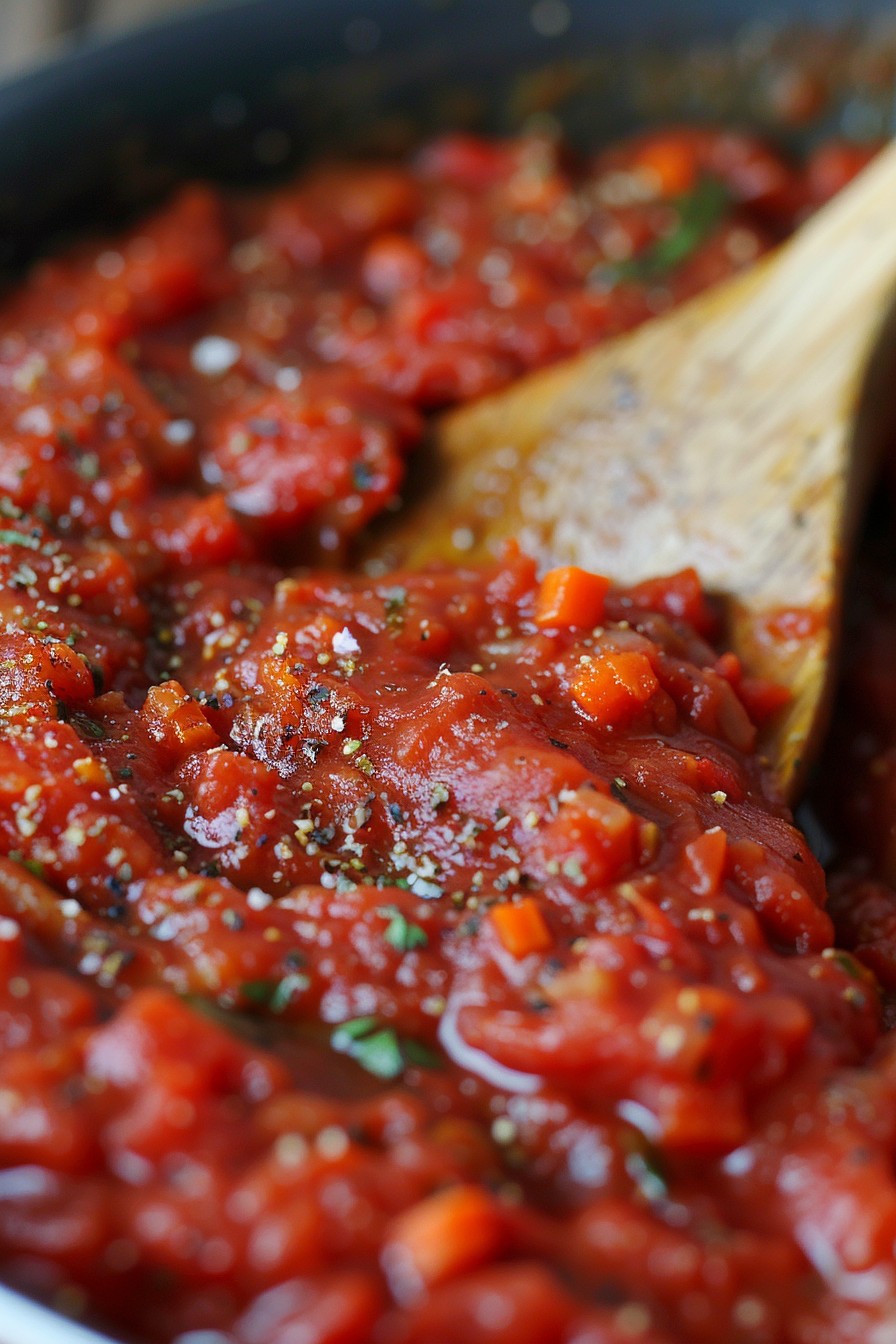Get ready to dive into a bowl of comfort with this no-meat pasta sauce that’s bursting with flavor. Great for vegetarians or anyone looking to lighten up their pasta night without sacrificing taste.
Why This Recipe Works
- Packed with vegetables for a nutritious twist on traditional pasta sauce.
- Uses simple, pantry-staple ingredients to whip up something delicious in no time.
- The slow simmering process deepens the flavors, making it taste like it’s been cooking all day.
- Versatile enough to pair with any pasta shape or even use as a pizza sauce.
- Freezes beautifully, so you can make a big batch and save some for later.
Ingredients
- 2 tbsp olive oil
- 1 large onion, diced
- 3 garlic cloves, minced
- 1 bell pepper, diced
- 2 carrots, grated
- 1 zucchini, grated
- 28 oz can crushed tomatoes
- 6 oz tomato paste
- 1 tsp sugar
- 1 tsp salt
- 1/2 tsp black pepper
- 1 tsp dried basil
- 1 tsp dried oregano
- 1/2 tsp red pepper flakes (optional)
- 1 cup water
Equipment Needed
- Large pot
- Wooden spoon
- Measuring cups and spoons
- Knife and cutting board
Instructions

Step 1: Sauté the Vegetables
Heat the olive oil in a large pot over medium heat. Add the diced onion and minced garlic, sautéing until the onion is translucent, about 5 minutes. Tip: Don’t rush this step; letting the onions cook slowly brings out their natural sweetness.
Step 2: Add the Remaining Vegetables
Stir in the bell pepper, grated carrots, and zucchini. Cook for another 5 minutes, until the vegetables start to soften. This mix adds color, texture, and nutrients to your sauce.
Step 3: Incorporate Tomatoes and Seasonings
Pour in the crushed tomatoes and tomato paste, then add the sugar, salt, black pepper, dried basil, dried oregano, and red pepper flakes if using. Stir well to combine. Tip: The sugar helps balance the acidity of the tomatoes.
Step 4: Simmer the Sauce
Add the water and bring the sauce to a simmer. Reduce the heat to low and let it cook uncovered for at least 30 minutes, stirring occasionally. The longer it simmers, the more the flavors will meld together.
Step 5: Adjust Seasonings and Serve
Taste the sauce and adjust the seasonings as needed. Serve over your favorite pasta, garnished with fresh basil or Parmesan cheese if desired.
Tips and Tricks
For an even richer flavor, try roasting the vegetables before adding them to the pot. This caramelizes their natural sugars and adds depth to the sauce. If you’re short on time, a food processor can quickly chop the vegetables, though hand-chopping gives a more rustic texture. Don’t skip the simmering step; it’s crucial for developing the sauce’s flavor. For a smoother sauce, blend it with an immersion blender before serving. And remember, this sauce tastes even better the next day, so consider making it ahead of time.
Recipe Variations
- For a creamy version, stir in 1/2 cup of heavy cream or coconut milk at the end of cooking.
- Add a cup of cooked lentils or chickpeas for extra protein and texture.
- Spice it up with more red pepper flakes or a diced jalapeño for those who like it hot.
- Incorporate other vegetables like mushrooms, eggplant, or spinach for different flavors and nutrients.
- Use fresh herbs instead of dried for a brighter taste, especially in the summer when they’re abundant.
Frequently Asked Questions
Can I freeze this sauce?
Absolutely! This sauce freezes beautifully. Let it cool completely, then transfer it to airtight containers or freezer bags. It’ll keep for up to 3 months. Thaw in the fridge overnight and reheat on the stove when ready to use.
What’s the best way to serve this sauce?
This sauce is versatile. Serve it over any pasta shape, use it as a base for lasagna, or even as a dipping sauce for bread. For a low-carb option, try it over zucchini noodles or spaghetti squash.
Can I make this sauce in a slow cooker?
Yes, you can. After sautéing the vegetables, transfer everything to a slow cooker and cook on low for 6-8 hours or on high for 3-4 hours. The slow cooker method is great for deepening the flavors without much hands-on time.
Summary
This no-meat pasta sauce is a flavorful, veggie-packed alternative to traditional meat sauces. Easy to make, versatile, and freezer-friendly, it’s sure to become a staple in your recipe collection.